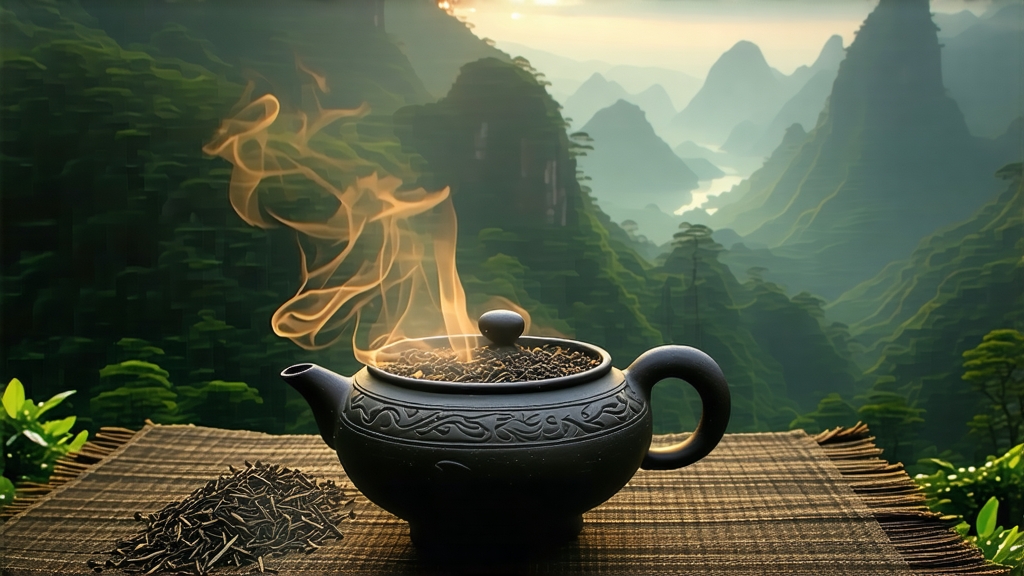
Long before English breakfast tables knew the word “black tea,” caravans loaded with dark, leathery leaves left the granite gorges of northern Fujian. Their destination was the Baltic port of Riga, then Amsterdam, then London. The cargo was Lapsang Souchong—today celebrated as the first fully oxidised tea ever created, great-grandparent to every subsequent black tea on earth. To international drinkers the name evokes campfire romance; to Chinese growers it is simply zheng shan xiao zhong, “small-leaf variety from the original mountain.” Both stories are true, and both begin in the same place: the 1,200-metre-high Wuyi Biosphere Reserve where mist, pine and volcanic soil conspire to craft a tea that is simultaneously rugged and refined.
History: From Accident to Export
Local legend places the birth of Lapsang Souchong during the late Ming dynasty, around 1604. An army unit passing through Tongmu village commandeered tea sheds, delaying the usual green-tea firing schedule. To save the oxidising leaves, farmers rushed them over burning pine boughs; the smoke dried and flavoured the tea in one stroke. Dutch traders who received the first samples were captivated by the novel dark colour and long shelf life. By the early Qing the East India Company listed “Bohea Souchong” among its most valuable commodities, paying for it with Mexican silver. European demand soon eclipsed tribute-grade green tea; even Keemun and Assam were later developed to imitate the brisk maltiness that Lapsang had taught the world to crave.
Terroir: Why Only Tongmu Tastes Like Tongmu
Within the Wuyi range the State Council has drawn a 50 km² “core origin” zone where commercial logging is banned and pesticides are illegal. Here Jurassic-era granites weather into sandy, slightly acidic loam rich in potassium and magnesium. Day-night temperature swings of 15 °C slow leaf growth, concentrating theanine and volatile aromatics. Indigenous C. sinensis var. bohea bushes sprout small, thick leaves that look almost black when mature. Crucially, the forest is 80 % Masson pine; fallen needles and centuries of resinous smoke have impregnated every wooden beam in the village, creating an environment impossible to replicate elsewhere. Move the same cultivar fifty kilometres downhill and the resulting tea is pleasant but lacks the trademark pine-oil sweetness.
Leaf Grades: From Souchong to Pekoe
Lapsang is not a single tea but a family sorted by pluck standard and smoke intensity.
- Souchong: two leaves and a bud, lightly withered, cold-smoked for 8–10 h; malt forward, cocoa notes, smoke hovers like background violin.
- Pekoe (also called “unsmoked Lapsang”): same raw leaf, hot-air dried in bamboo baskets; cup is honey-amber, aroma of longan and dried rose, zero tar.
- Wild Lapsang: picked from un-pruned shrubs above 1,400 m; needle-thin leaves, natural fruity sweetness, only a whisper of smoke so as not to mask hints of lychee and cinnamon.
- Gongfu Cut: leaf intentionally bruised into tight curls to suit short infusions; favoured in Michelin-starred kitchens for pairing with duck and chocolate desserts.
Craft: The Eight Stages of Pine-Smoke Alchemy
- Pluck before Qingming while aphids are still asleep; dew must evaporate so no green bite remains.
- Wither on bamboo racks above a ground-level pine ember pit kept at 28 °C; moisture drops from 75 % to 45 % in 3 h while resin vapours begin to cling.
- Roll 45 min under light pressure to rupture 70 % of cell walls without shredding the leaf; this releases catechins and polyphenol oxidase.
- Oxidise inside cedar-lined boxes at 24 °C, 85 % humidity. Leaves turn from jade to copper to mahogany in 2–4 h; master sniffers judge readiness by the disappearance of grassy top notes and the emergence of ripe-apple sweetness.
- Pan-fire at 200 °C for 90 s to halt oxidation; the “kill-green” step fixes colour and prevents sourness.
- Hot-smoke over fresh pinewood embers (no open